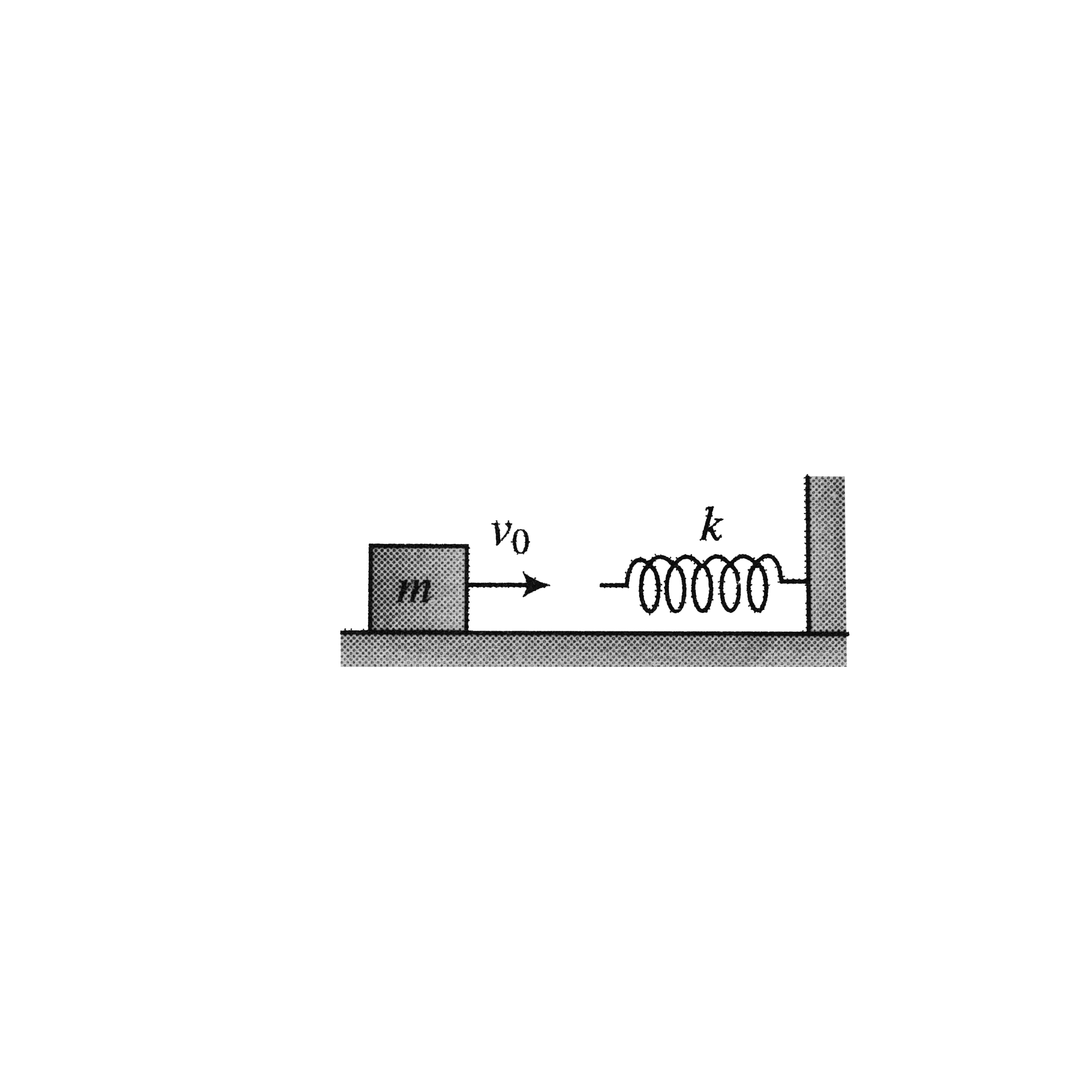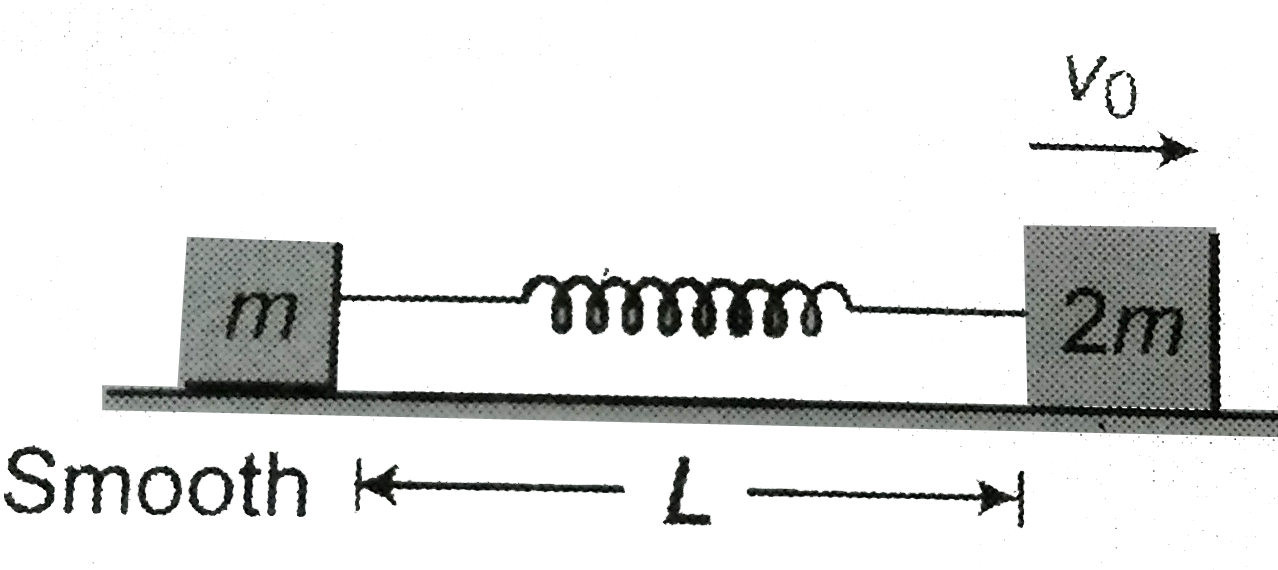Two blocks of masses m1andm2 are connected by a spring of spring constant k figure. The block of mass m2 is given a shape impulse so that it acquires a velocity v0 towards right. Find a. the velocity of the centre of mass b. the maximum elongation that the spring will suffer.
 Solution in Tamil
Solution in Tamil
Velocity of centre of mass
=m1v1+m2v2m1+m2
Hence v1=0,v2=v0
=m1×0+m2×v0m1+m−2
=m2v0m1+m2
b. The spring wil attain maximum elongation when both velocities of two blocks wil attain are veolicy of centre of mass.
x→maxiμmelongationofspr∈g<br>chan≥∈k∈etice≠rgy<br>=potentiale≠rgys→red∈spr∈g<br>rarr 1/2 m_2v_2^2-1/2(m_1+m_2)((m_2v_0)/(m_1+m_2))^2<br>=1/2kx^2<br>rarr m_2v_0^2(1-m^2/(m_1+m_2)=kx^2<br><imga≤ocr_imageload∈g=lazysrc=https://d10lpgp6xz60nq.cloudfront.net/physics_images/HCV_VOL1_C09_E01_104_S01.pngwh=80%mx-autosty≤=background:white;><br>rarr x=[(m_1m_2)/(m_1+m_2)]^91/2)V_0
Topper's Solved these Questions
Similar Questions
The centre of mass of a system of particles is at the origin. It follows that:
04:06View SolutionAn aluminium vessel of mass 0.5kg contains 0.2kg of water at 20∘C A block of iron of mass 0.2kgat100∘C is gently put into the water .Find the equilibrium temperature of the mixture, Specific heat capacities of aluminium , iron and water are 910Jkg−1K−1470Jkg−1K−1and4200Jkg−1K−1 respectively
05:07View SolutionFind the accelerationof the moon with respect to the eath from the following data, Distance between the earth and the moon =3.85×105 km and the time taken by the moon to complete one revolution around the earth =27.3days
08:46View SolutionA block of mass m is moving with an initial velocity v0 towards a stationary spring of stiffness k attached to the wall as shown in figure

a. Find the maximum compression in the spring.
b. Is the work done by the spring negative or positive?04:39View SolutionA spring-mass system ( m_1 + massless spring + m_2 ) fall freely from a height h before m_2 colliding inelastically with the ground. Find the maximum value of h so that block m_2 will break off the surface. Assume k=stiffness of the spring.
04:17View SolutionA block of mass m moving at a speed v_0 compresses a spring of spring constant k as shown in the figure. Find (a) the maximum compression of spring and (b) speed of the block when the spring is compressed to half of maximum compression.
04:31View SolutionBlock of mass 2m is given v0 towards the right. If L is the natural length of spring constant k, find the maximum elongation of the spring.
 06:01View Solution
06:01View SolutionA block of mass m_1 is lying on the edge of a rough table. The coefficient of friction between the block and the table is mu . Another block of mass m_2 is lying on another horizontal smooth table. The two block are connected by a horizontal spring of force constant K. Block of mass m_2 is pulled to the right with a constant horizontal force F. (a) Find the maximum value of F for which the block of mass m1 does not fall off the edge. (b) Calculate the maximum speed that m_2 can acquire under condition that m_1 does not fall.
01:43View SolutionBlocks A&B of mass m each are connected with spring of constant k both blocks lie on frictionless ground and are imparted horizontal velocity v as shown when spring is unstretched find the maximum stretch of spring.
02:49View SolutionA block of mass m is placed on a smooth block of mass M = m with the help of a spring as shown in the figure. A velocity v_(0) is given to upper block when spring is in natural length. Find maximum compression in the spring.
06:36View SolutionThe block of mass m is released when the spring was in its natrual length. Spring constant is k. Find the maximum elongation of the spring.
 02:21View Solution
02:21View Solutionएक m द्रव्यमान का ब्लॉक एक k स्प्रिंग नियतांक की स्प्रिंग से चित्रानुसार जुड़ा है। ब्लॉक में महत्तम विस्थापन है
02:10View SolutionA spring connects two particles of masses m1andm2 A horizontal force F acts on m1 Ignoring friction, when the elongation of the spring is x then:
 02:44View Solution
02:44View Solutionदो द्रव्यमान m1 व m2 को एक स्प्रिंग के द्वारा चित्रानुसार जोड़ा गया है। निकाय को ऊँचाई से धरातल की ओर छोड़ा जाता है । स्प्रिंग होगी
 02:24View Solution
02:24View SolutionA block of mass m is moving with an initial velocity v_0 towards a stationary spring of stiffness k attached to the wall as shown in figure a. Find the maximum compression in the spring. b. Is the work done by the spring negative or positive?
04:00View SolutionA spring-mass system ( m_1 + massless spring + m_2 ) fall freely from a height h before m_2 colliding inelastically with the ground. Find the maximum value of h so that block m_2 will break off the surface. Assume k=stiffness of the spring.
03:47View Solution

